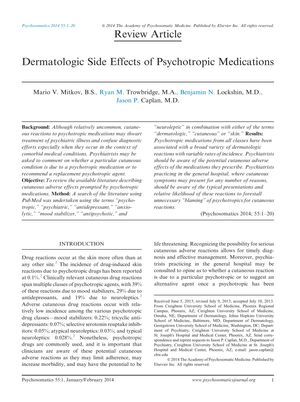Dermatologic Side Effects of Psychotropic Medications
October 2013
in “
Psychosomatics
”

TLDR Psychotropic medications can cause skin reactions, including severe conditions like SJS and TEN, and it's important for psychiatrists to recognize and manage these side effects.
The 2014 review article examined the dermatologic side effects of psychotropic medications, noting a 0.1% incidence of drug-induced skin reactions, with mood stabilizers, antidepressants, and neuroleptics as common causes. It emphasized the importance of psychiatrists being aware of potential cutaneous adverse effects for timely diagnosis and management. Severe reactions like Stevens-Johnson syndrome (SJS) and toxic epidermal necrolysis (TEN) have mortality rates of 5%-30%, often caused by medications such as carbamazepine and lamotrigine. A study of 115 patients indicated that 67.8% of SJS and TEN cases were due to carbamazepine. Alopecia, a reversible hair loss, is associated with tricyclic antidepressants, lithium, and anticonvulsants. The incidence of cutaneous reactions with mood stabilizers was reported at 0.23% in 208,401 patients, and antidepressants had a 0.054% incidence in 109,000 patients. SSRIs have a 0.051% incidence of cutaneous reactions, with fluoxetine associated with hyperhidrosis. TCAs have a higher incidence of 0.073%, with 4% of 599 patients reporting cutaneous side effects. The document also discusses the importance of patient education, proper drug titration, and dermatologic consultation in managing these reactions.










